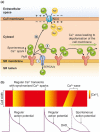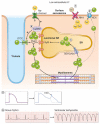Hypokalemia-Induced Arrhythmias and Heart Failure: New Insights and Implications for Therapy
- PMID: 30464746
- PMCID: PMC6234658
- DOI: 10.3389/fphys.2018.01500
Hypokalemia-Induced Arrhythmias and Heart Failure: New Insights and Implications for Therapy
Abstract
Routine use of diuretics and neurohumoral activation make hypokalemia (serum K+ < 3. 5 mM) a prevalent electrolyte disorder among heart failure patients, contributing to the increased risk of ventricular arrhythmias and sudden cardiac death in heart failure. Recent experimental studies have suggested that hypokalemia-induced arrhythmias are initiated by the reduced activity of the Na+/K+-ATPase (NKA), subsequently leading to Ca2+ overload, Ca2+/Calmodulin-dependent kinase II (CaMKII) activation, and development of afterdepolarizations. In this article, we review the current mechanistic evidence of hypokalemia-induced triggered arrhythmias and discuss how molecular changes in heart failure might lower the threshold for these arrhythmias. Finally, we discuss how recent insights into hypokalemia-induced arrhythmias could have potential implications for future antiarrhythmic treatment strategies.
Keywords: Na+ - K+-ATPase; arrhythmia (heart rhythm disorders); calcium; heart failure; hypokalaemia.
Figures


References
-
- (1982). Multiple risk factor intervention trial. Risk factor changes and mortality results. The Multiple Risk Factor Intervention Trial Research Group. JAMA 248, 1465–1477. - PubMed
-
- (1984). The effect of antihypertensive drug treatment on mortality in the presence of resting electrocardiographic abnormalities at baseline: the HDFP experience. The hypertension detection and Folow-up Program Cooperative Research Group. Circulation 70, 996–1003. - PubMed
Publication types
LinkOut - more resources
Full Text Sources
Miscellaneous

